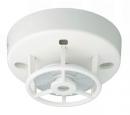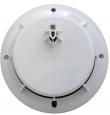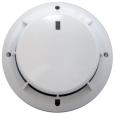Hochiki Conventional Smoke Detector
Hochiki Beam Detector
APPLICATION
The Hochiki America SPC-24 Projected Beam Smoke Detector consists of an emitter and receiver. The projected beam smoke detector should be placed so that smoke generated by a fire will likely rise into the path of the beam. The receiver is constantly monitoring and measuring the intensity of the beam transmitted by the emitter. Should the smoke from a fire cause a decrease in the signal strength of a magnitude that exceeds the programmed obscuration setting, an alarm signal is generated. The SPC-24 Projected Beam Smoke Detector can provide vital fire detection in applications where other types of detectors may not be able to respond quickly, or at all, to a fire condition. Examples of some applications where projected beam smoke detectors have been successfully used include: atriums gymnasiums theatres museums factories tunnels churches stables warehouses anecoic chambers high air velocity areas The Hochiki America SPC-24 Projected Beam Smoke Detector may also be used in conjunction with more traditional spot type smoke detection devices to provide an even more comprehensive detection system
OPERATION
The near infrared pulsed beam generated by the emitter is sensed by the photodiode of the receiver, where it is converted into an electrical signal. This signal is then amplified and applied, via an analog to digital converter, to a microprocessor. The normal state signal (the initial beam data) once stored in the microprocessor is used as reference for comparison with subsequent beam signals. When there is a difference between actual beam strength and stored reference data that exceeds the programmed alarm obscuration reference level, a fire signal is produced. A trouble signal is generated if the beam is more that 90% obstructed (as opposed to partially obscured by smoke). The microprocessor also provides compensation for a change in received signal value, with time, caused by contamination of the optics. Since such a change with time appears as a slow change in the beam signal, the microprocessor compensates in such a manner that the signal moves closer to the reference data at a rate approximately +1% per hour. When this compensating capability reaches a limit, the SPC-24 automatically generates a trouble signal. A calibrated test filter is available upon request to test and verify the sensitivity setting of the SPC-24 projected beam smoke detectors.
STANDARD FEATURES
• Microprocessor based for reliability
• Simple setup & alignment with signal strength LED's
• Provides 60 feet on center linear protection at a range of 32.8 feet to 328 feet
• Automatic compensation for signal drift or dirty lens
• Three field adjustable sensitivity settings
• Form A alarm and Form B trouble contacts
• Calibrated filters available to verify sensitivity
• Color-coded emitter and receiver labels for easy recognition
SPECIFICATIONS
- Rated Voltage 24VDC
- Working Voltage 19VDC - 33VDC
- Supervisory Current Emitter 50 A @ 24VDC; Receiver 200 A @24VDC
- Alarm Current 20mA @ 24DC
- Trouble Current 20mA @ 24VDC
- Installation Temperature Range 32° F - 100° F
- Sensitivity Test Feature Hochiki test filters
- Allowable missalignment Emitter +/- 0.5° angle (MAX) Reciever +/-1.0°
- Dimensions 5.5" Tall 3.2" Wide 4.0" Deep
- Mounting Wall mount
- Maximum Humidity 95% R.H. non-condensing














